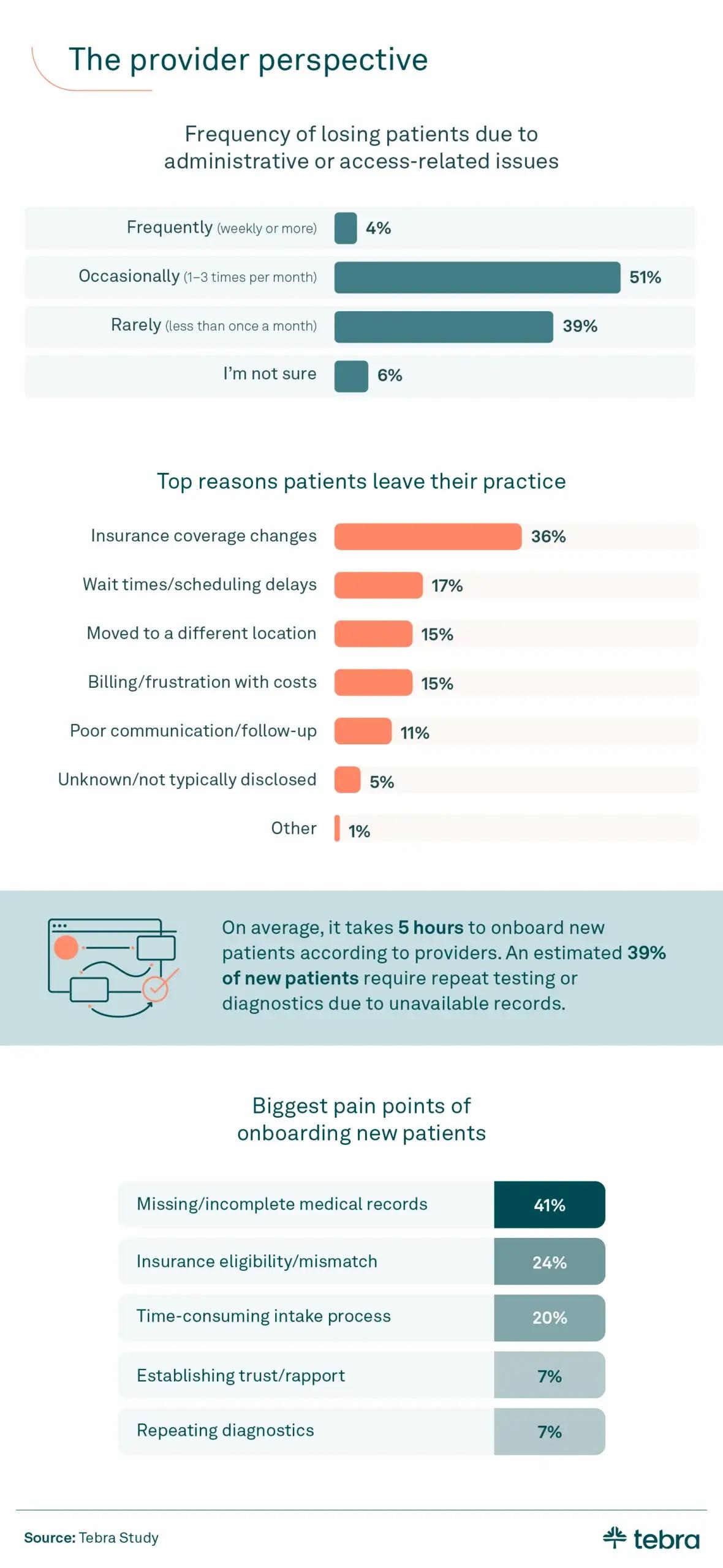Overview
-
- 37% of patients have had to change doctors in the past 2 years, and 28% said the experience made them lose trust in the healthcare system.
-
- On average, it took patients 5 months and 2 switches to find a new doctor.
-
- 39% avoided care for a medical concern to avoid restarting the process with someone new.
-
- Patients spend an average of $485 to re-establish care after switching providers.
-
- 45% of patients have stayed with a doctor they weren’t happy with just to avoid the hassle of switching.
-
- Digital patient engagement tools like online scheduling, patient portals and seamless record sharing can significantly reduce barriers to switching care.
Changing doctors can disrupt continuity of care, create administrative burdens, add unnecessary healthcare expenses, and erode patient trust. Patients often face stress from repeatedly explaining medical histories or duplicating tests, highlighting the need for technology-enabled care coordination to simplify transitions
In this article, we explore the real-world costs of switching doctors, drawing insights from a Tebra survey of 750 patients and 250 healthcare professionals. You'll learn why patients make the switch, what it costs them in time, money, and mental health, and how providers are impacted by churn. We'll also highlight digital tools that help reduce friction and why keeping patients happy could be a provider's most valuable investment.
Key takeaways
- 37% of patients have had to change doctors in the past 2 years, and 28% said the experience made them lose trust in the healthcare system.
- On average, it took patients 5 months and 2 switches to find a new doctor.
- 39% avoided care for a medical concern to avoid restarting the process with someone new.
- Patients spend an average of $485 to re-establish care after switching providers.
- 45% of patients have stayed with a doctor they weren't happy with just to avoid the hassle of switching.
- Digital patient engagement tools like online scheduling, patient portals and seamless record sharing can significantly reduce barriers to switching care.
Why patients switch and what retains them
For some patients, switching doctors means navigating time-consuming hurdles and disruptions in care.

Over one-third of patients (37%) reported switching doctors in the past 2 years, primarily due to providers becoming out-of-network (29%) or they felt unheard or disrespected (26%). The most significant frustrations included restarting the care process from scratch (53%) and repeatedly explaining their medical history (46%). Nearly 1 in 4 had to repeat labs or diagnostics. Digital solutions that streamline patient onboarding, automate medical record sharing and provide transparent communication can address these pain points and foster patient loyalty.
It took patients an average of 5 months and two attempts to find a new doctor. This experience damaged patient trust, with 28% saying it made them lose confidence in the healthcare system. Many avoided switching altogether. In fact, 45% stayed with a provider they were not satisfied with, and another 45% delayed care because the process felt too difficult.
When asked what matters most in a provider, 81% of patients pointed to feeling heard, and 51% said online scheduling made their experience easier. To retain patients, private practices can use digital tools to improve the experience.
According to patients, the top features that build loyalty and make it easier to stick with one provider are online scheduling (51%), access to lab results (50%), and secure messaging (42%). EHR software that integrates these tools can help practices streamline the care journey, reduce administrative burdens, and keep patients engaged for the long term.
The emotional and financial costs of starting over
Beyond inconvenience, switching doctors comes with measurable emotional and financial costs that can affect a patient's overall well-being.

Patients spent an average of $485 to re-establish care with a new provider, and 14% had to take time off work to do so. Nearly 40% delayed addressing health concerns altogether to avoid restarting with someone new. Emotional impacts were equally significant – 50% reported anxiety, and 47% felt stressed during the transition. Healthcare technology solutions, such as interoperable electronic health records (EHR), secure patient portals and automated digital intake can reduce redundancy, minimize stress and facilitate smoother care transitions.
Unfortunately, 16% felt their new provider misunderstood or overlooked the care they had previously received. That kind of disconnect can make patients feel like they're starting from square one. With the right EHR tools, private practices can quickly learn a patient's history and avoid repeating tests or missing critical information.
How switching impacts providers
When patients switch doctors, it creates logistical and operational challenges for healthcare providers. From onboarding new patients to maintaining continuity of care, the process can strain both time and resources.

Around half of providers (51%) reported losing patients monthly (1–3 times per month) due to administrative burdens or access-related issues. Providers highlighted the these digital tools as the top 5 most effective in reducing churn: :
- Online scheduling (73%)
- Easy medical record access (72%)
- Patient portals/chat features (65%)
- Automated follow-up reminders (65%)
- Transparent billing/cost estimator (59%)
Providers estimated that onboarding a new patient takes an average of 5 hours. They also reported that 39% of new patients required repeat testing because prior records were unavailable. The top onboarding pain points were missing or incomplete medical records (41%), insurance eligibility (24%), and a time-consuming intake process (20%).
For private practices with limited staff and resources, leveraging integrated EHR platforms and automation technologies can significantly streamline patient onboarding reduce inefficiencies and improve patient retention, allowing providers more time for personalized care
Conclusion: Reducing Churn Starts With Better Systems
Switching doctors impacts patient trust, healthcare quality and provider efficiency. However, the right digital healthcare systems can significantly reduce the complexity of changing providers.Online scheduling, patient portals, transparent billing and interoperable medical records help streamline the transition process. Investing in technology-enabled solutions not only improves patient experience but also positions private practices competitively against larger healthcare systems by reducing administrative burdens and enhancing personalized patient relationships.
Methodology
Tebra surveyed 750 American patients and 250 healthcare professionals on June 12, 2025, using a structured questionnaire addressing patient-provider experiences, administrative burdens and perceptions of healthcare technology’s role in easing care transitions. Responses are self-reported.
About Tebra
Tebra, headquartered in Southern California, empowers independent healthcare practices with cutting-edge AI and automation to drive growth, streamline care, and boost efficiency. Our all-in-one EHR and billing platform delivers everything you need to attract and engage your patients, including online scheduling, reputation management, and digital communications.
Inspired by "vertebrae," our name embodies our mission to be the backbone of healthcare success. With over 165,000 providers and 190 million patient records, Tebra is redefining healthcare through innovation and a commitment to customer success. We're not just optimizing operations — we're ensuring private practices thrive.
Fair Use Statement
Please feel free to share this article. We only ask that you use it for noncommercial purposes and include a link back to this page so readers can explore the full findings and methodology.







